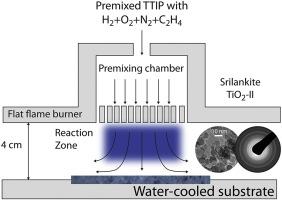Journal of Aerosol Science ( IF 3.9 ) Pub Date : 2021-03-05 , DOI: 10.1016/j.jaerosci.2021.105775 Ashley M. Pennington , Hadi Halim , Jonathan Shi , Bernard H. Kear , Fuat E. Celik , Stephen D. Tse

|
Nanoparticulate (3–10 nm) TiO2 polymorphs, i.e., rutile, anatase, and srilankite (also known as TiO2-II or α-PbO2-type TiO2) phases are produced via low-pressure (e.g., 20 torr) flame synthesis at temperatures ranging from 1560K to 2650K, with burner flow velocities varying from 150 to 300 cm/s, using titanium tetra-isopropoxide (TTIP) as precursor. Interestingly, added carbon (i.e., ethylene) in the feed stream produces nanoparticles of the generally characteristic low-temperature high-pressure metastable srilankite phase. The as-synthesized nanopowder is composed of either rutile or srilankite phase, with composition dependent on particle residence time in the flow field. Under the same conditions, feed gas without carbon, e.g., hydrogen, yields anatase phase TiO2. Post heat treatment up to 773K in thermogravimetric analysis (TGA) and differential scanning calorimetry (DSC) highlights the thermal stability of the samples, while x-ray photoelectron spectroscopy (XPS) indicates the presence of carbon, with absences of Ti3+, Ti–C, and nitrogen. Microscopy reveals morphology on both the micrometer scale (scanning electron microscopy, SEM) and nanometer scale (transmission electron microscopy, TEM), while x-ray diffraction (XRD) and selected area electron diffraction (SAED) confirm polymorph variation under different synthesis conditions. CHN analysis determines that the synthesized srilankite contains a greater weight percentage of carbon than does anatase. Excess carbon doped into the lattice during low-pressure flame synthesis seems to be the key in stabilizing the high-pressure srilankite phase for such nanoparticles.
中文翻译:

低压火焰合成碳稳定的TiO 2 -II(绢云母)纳米粒子
纳米颗粒(3-10纳米)的TiO 2多晶型物,即,金红石,锐钛矿,和srilankite(也称为二氧化钛2 -II或α-PBO 2型的TiO 2通过四氟异丙醇钛(TTIP)作为前驱体,在1560K至2650K的温度范围内,通过低压(例如20托)火焰合成来产生相,燃烧器的流速从150至300 cm / s不等。有趣的是,进料流中添加的碳(即乙烯)会产生通常具有特征性的低温高压亚稳态绢云母相的纳米颗粒。合成后的纳米粉体由金红石相或绢云母相组成,其组成取决于流场中的颗粒停留时间。在相同条件下,不含碳的原料气(例如氢气)会产生锐钛矿相TiO 2。在热重分析(TGA)和差示扫描量热法(DSC)中进行的高达773K的后热处理突出了样品的热稳定性,而X射线光电子能谱(XPS)则表明存在碳,而没有Ti 3+,Ti-C和氮。显微镜揭示了微米级(扫描电子显微镜,SEM)和纳米级(透射电子显微镜,TEM)的形态,而X射线衍射(XRD)和选定区域电子衍射(SAED)证实了在不同合成条件下多晶型的变化。CHN分析确定,合成的斯里兰卡沸石比锐钛矿所含的碳重量百分比更高。在低压火焰合成过程中,过量的碳掺杂到晶格中似乎是稳定此类纳米粒子的高压绢晶相的关键。


















































 京公网安备 11010802027423号
京公网安备 11010802027423号